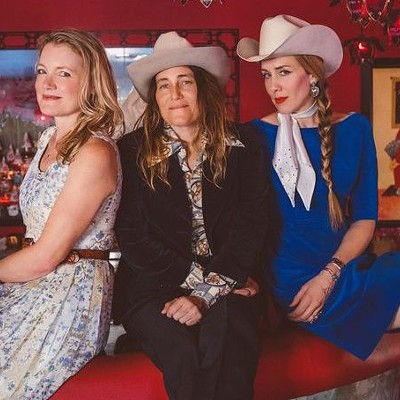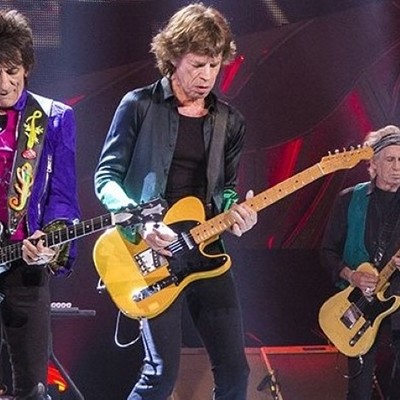While it may not often be recognized by "mainstream listening audiences," post-hardcore is not a dead genre. Though its popularity has often waxed and waned throughout the years since its inception in the mid '80s, there are always great upstart bands keeping it alive. As of late, the genre has seen something of a big revival in the wake of two of its most important bands reuniting for Coachella performances, those bands being At the Drive-In and Refused.
One of the fundamental genetic make-ups of the genre is that one does not have to be the most technically proficient shredder in the world to be a great guitarist. Sometimes all it takes to influence an entire genre is a little charisma, a few power chords, some hammer-ons and pull-offs, and genuine emotion pouring through each note one plays. In other words, no matter how many notes he can play a second, Yngwie's got nothing on these guys. Because the genre is so vast and covers so many styles, it may be impossible to make a definitive list, but here are the post-hardcore guitarists I feel shaped their contemporaries and the future of the genre for years to come.
Ian MacKaye and Guy Piccioto (Fugazi) Whether it's through their groundbreaking early bands that shaped the eventual sounds of emo and post-hardcore (see: Rites of Spring, Minor Threat), almost single-handedly revolutionizing punk as a whole with their longest lasting band, the legendary Fugazi, running Dischord Records (home to other punk and post-hardcore legends like Jawbox, Q and Not U, and Nation of Ulysses), or doing production work for bands such as Rollins Band, John Frusciante, Bikini Kill, and the Blood Brothers, Ian MacKaye and Guy Piccioto are maybe the most important men in post-hardcore of all time and two of the most important men in punk and indie music over the last thirty years.
While the bassline from their biggest hit "Waiting Room" is probably what most people think of when they think of Fugazi, there's simply no denying that the noisy, dissonant guitar playing of both MacKaye and Piccioto influenced an entire generation of emotional and pissed off teenagers. Though Fugazi has remained on indefinite hiatus since 2001, we can always hope and dream of the reunion they have continually promised will one day happen.
Steve Albini (Shellac) Singer/songwriter, guitarist, bassist, drummer, producer, music journalist, is there anything this man doesn't do when it comes to music? It's impossible to overstate Albini's influence on punk, post-hardcore, indie rock, and noise rock. He has continued to be an important figure in the scene for thirty years and has transcended it into the mainstream of rock and roll. All three of his main bands, Big Black, Rapeman, and Shellac, have gone on to become classics. But his biggest contribution is not just in playing guitar but in shaping the actual sound of the guitars.
The tones used, the production employed. It would take far too long to list the famous bands he has produced for in any number of different genres, but the most important ones to the sound of the guitar in post-hardcore are definitely Nirvana, the Pixies, Helmet, Jawbreaker, the Jesus Lizard, and Superchunk. While these bands are not necessarily post-hardcore themselves, it was in large part due to the sound of these bands that post-hardcore bands created their own tones and sounds.
Rick Froberg and John Reis (Drive Like Jehu) These two started around the same time as MacKaye and Piccioto, with their first band Pitchfork (1986-1990) and then perhaps their most famous one Drive Like Jehu (1990-1995). They would go on to perform together and separate in still more influential bands over the next twenty years including Rocket from the Crypt (1989-2005), Hot Snakes (1999-2005 and some recent reunion gigs, including one at the 2011 edition of Austin's Fun Fun Fun Fest), Sultans (2000-2007), Obits (2006-present), and The Night Marchers (2007-present).
Their impact has been massive on the future of the genre, particularly from their introduction of math rock influences into Drive Like Jehu's guitar playing, featuring complex breakdowns and jerky rhythms. This has led to covers from bands as far removed from post-hardcore as the Deftones and frontman for At the Drive-In, Cedric Bixler-Zavala, to say they were "just emulating Drive Like Jehu."
Victor Villareal (Cap'n Jazz) Deep in the underground in 2012, there exists a movement towards lo-fi emotional post-hardcore. It sounds like it was thrown together by some teenagers in a basement and it features intense screaming and twinkly guitars affected with a slight math rock influence. One can find these elements in every band on this list, but no one band brought together each and every one of these aspects in conjunction so well as Cap'n Jazz. Throughout the '90s, they pioneered this sound and one of the more prominent aspects of the band being bitten by current bands is the guitar playing of Victor Villareal.
While brothers Tim and Mike Kinsella, vocalist and drummer respectively, have attained greater attention through their subsequent emo projects, Villareal was the provider in Cap'n Jazz of all those melodies played high on the neck of the guitar, so fragile they sounded like they might break at any moment, and all the start-stop math rock moments. It's this that may be the most important part of their sound that is rearing its head in the underground today. As for Villareal, he's currently on tour with his first solo album of acoustic music.
Omar Rodriguez-Lopez, Jim Ward, and Cedric Bixler-Zavala (At the Drive-In) This trio made up the ultimate core of the recently reunited and much beloved band At the Drive-In. Though the band was started by guitarist Jim Ward and vocalist Cedric Bixler-Zavala in 1993, they really came into their own with the induction of second guitarist Omar Rodriguez-Lopez in 1996. They had all been playing in local punk bands from El Paso, Texas, from 1991 on, including bands like Foss, Startled Calf, Los Dregtones, and The Fall on Deaf Ears, but the magic started to happen around the first full-length At the Drive-In album, Acrobatic Tenement.
From then on out, the band continued on an upward trend until their implosion in 2001. With their twinkly lead guitar lines influenced by bands like the Smiths played over heavy dissonant chords reflecting their Fugazi influence, they came the closest yet to bringing post-hardcore to the mainstream with their hit "One Armed Scissor". While their official guitar duo was made up of Rodriguez-Lopez and Ward, it has recently come to light through his YouTube account that Bixler-Zavala also contributed a great deal of the guitar playing and writing, going uncredited for these contributions. I decided to include him among their guitarists anyway, as he definitely helped shape their guitar sound to become as massive as it was.
After their split, Rodriguez-Lopez and Bixler-Zavala would form their progressive rock project The Mars Volta where Rodriguez-Lopez's guitar playing would only get crazier and more complex and Ward would take the rest of At the Drive-In with him to another post-hardcore band, Sparta.





